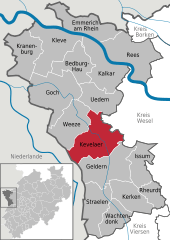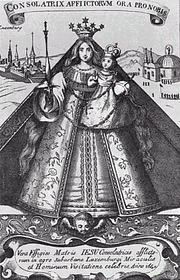Kevelaer
| Kevelaer | ||
|---|---|---|
| ||
 Kevelaer | ||
Location of Kevelaer within Kleve district 
 | ||
| Coordinates: 51°35′0″N 06°15′0″E / 51.58333°N 6.25000°ECoordinates: 51°35′0″N 06°15′0″E / 51.58333°N 6.25000°E | ||
| Country | Germany | |
| State | North Rhine-Westphalia | |
| Admin. region | Düsseldorf | |
| District | Kleve | |
| Government | ||
| • Mayor | Dominik Pichler (SPD) | |
| Area | ||
| • Total | 100.6 km2 (38.8 sq mi) | |
| Population (2015-12-31)[1] | ||
| • Total | 28,311 | |
| • Density | 280/km2 (730/sq mi) | |
| Time zone | CET/CEST (UTC+1/+2) | |
| Postal codes | 47623 47627 | |
| Dialling codes | 0 28 32 | |
| Vehicle registration | KLE | |
| Website | www.kevelaer.de | |
Kevelaer is a municipality in the district of Kleve, in North Rhine-Westphalia in Germany. It is the best visited Catholic pilgrimage location within north-western Europe. More than 1 million pilgrims, mostly from Germany and the Netherlands, visit Kevelaer every year to honour the Virgin Mary. The population (as of 2011) is 28,873.
The town participates in international town twinning and it has twinned with Bury St. Edmunds, in the United Kingdom. In the Middle Ages, Bury was also an important place of pilgrimage.
Notable people
- Franz-Peter Tebartz-van Elst (born 1959), German prelate of the Catholic Church and theologian.
- Markus Meurer (born 1959), German outsider artist.
References
- ↑ "Amtliche Bevölkerungszahlen". Landesbetrieb Information und Technik NRW (in German). 18 July 2016.
External links
- Official site
- “Build Me A Chapel On This Spot”
- "Welcome to Pilgrimage centre of Kevelaer". Wallfahrtsleitung Kevelaer. Retrieved 2013-09-26.
- "The Pilgrimage Site of Kevelaer". Unverwechselbar Kevelaer. Retrieved 2013-09-26.

Basilica

Kevelaerer picture of Grace

Chapel
| Wikimedia Commons has media related to Kevelaer. |
This article is issued from Wikipedia - version of the 2/10/2016. The text is available under the Creative Commons Attribution/Share Alike but additional terms may apply for the media files.
